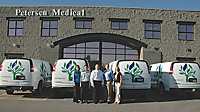YARMOUTH, Maine - While the April HME News Poll showed that nearly 67% of providers say "no thanks" to high-tech oxygen devices because of high-acquisition costs, others are forging ahead with new business models.
"If we don't have to deliver it, we find a way to like it," said Scott Lloyd, president of Norcross, Ga.-based upstart Extrakare.
Lloyd and his partner wrote their business plan with an eye to the economics of the non-delivery oxygen model. Financing Invacare's HomeFill transfilling concentrator over three years, for example, costs Lloyd $100 a month, but, he said, that burden goes away after three years, leaving him with equipment that has a useful life of eight to 10 years.
Lloyd declined to say how many oxygen patients the company has but said a 15% market share of the area's estimated 18,000 oxygen patients is Extrakare's goal.
Building from the ground up, he added, allows him to develop Extrakare's cost structure around a newer, leaner reimbursement environment--a luxury established HMEs often don't enjoy.
With average delivery costs across the country ranging from $45 to $75 per stop and likely to go higher, reducing deliveries allows providers to trim overhead and operate tighter ships on lower margins, said Lloyd. Shifting from the delivery model frees up time for customer service, which is good for patients, he said.
"They really have that independence that you just can't have with a traditional model," said Lloyd. "We think it will be much harder for providers who don't have great service levels to make it."
Customers also want freedom, agrees Tom Bradley, president of Orem, Utah-based Petersen Medical. Peterson has partnered with Evo to exclusively provide Inogen One portable concentrators in that state. He is banking on "overwhelming" interest in lightweight units to compel people to take a look at Petersen as a high quality provider. So far, it's working, he says.
"We're already receiving calls throughout the state that we probably wouldn't have otherwise because they are interested in the Inogen One," said Bradley. "We provide the technology and go well above and beyond what's required to make sure this equipment is adequate."
That translates into strong referral relationships, he said. With between 2,000 and 3,000 customers, and as the sole oxygen provider for Utah's Medicaid patients, Petersen is well-positioned to grab a bigger share of the oxygen market. Still, the company has entered the portable market cautiously, applying rigorous criteria to identify mobile patients who would benefit most.
"Not everyone is going to qualify, and yes, expense is part of that," said Bradley. "We can't put this on everyone, but we'd like to put it on as many people as we can." HME




Comments